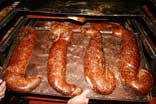The Key to Successful Challos
The Key to Successful Challos
A warm aroma envelopes the kitchen and you are transformed, by virtue of your golden Challa loaves, into the quintessential Jewish homemaker – the ‘Akeres haBayis’. In order to achieve this, here are some valuable tips:
Below is a range of guidelines culled from experts in the field:
The Dough
- The exact quantity of yeast is vital to the success of your Challa. Take care to use the required amount of yeast, since too little yeast will of course prevent the dough from rising sufficiently.
- Add the oil only once the dough has started taking shape, so that the dough will be easier to knead and won’t be too sticky.
- In order to allow for maximum rising, sprinkle flour over the kneaded dough and cover with a towel to prevent it from drying out.
- Allow enough time for rising: too short a time will produce a Challa that is dense and heavy.
- Make sure that room temperature is optimal - if the room is too warm the dough will rise too quickly and become ‘tired’; if the room is too cool, the dough will not rise fast enough resulting in a heavier dough that lacks fluffiness.
- For a particularly airy result, allow the dough to rise twice. After the first rising, punch it down and leave it to rise another ½ hour. However, make sure to leave ample ‘rest time’ in between the two risings.
Kneading
- It is important to knead the dough for the correct amount of time. Kneading the dough for too long weakens it, which in turn affects the fermentation of the yeast. However insufficient kneading will likewise prevent the dough from rising properly, so a happy medium is the way to go.
- It is advisable to raise the speed and intensity of the kneading gradually – this will produce a higher quality dough.
- Whilst kneading (particularly in the earlier stages), it is a good idea to stop every so often and clean off the dough from the sides of the bowl. In this way a smoother dough will result.
- After kneading, the dough should be transferred to a larger bowl in order to allow it space to expand.
The Baking
- After braiding the challos but before coating them with egg and placing them in the oven, leave them to rise for about ½ hour
- The baking tray should initially be at room temperature.
- Recommended baking time is usually 45 minutes in a regular oven.
- Oven temperature is important. Start with 200°c for about 10 minutes, and then lower to 180°c for 30 minutes. For the last 10 minutes the oven should be turned up again, to 200°c.
- It is of utmost importance to remove the Challos from the baking tray as soon as they are taken out the oven. This is in order to preserve their crispness, as leaving the Challah on its tray could lead to moisture gathering on the tray.
Good luck! After baking your Challos using these time-honored tips, everyone will be lining up to receive ‘Hafrashas Challa’!
Information courtesy of bakery advisors for the ‘KitchenAid’ company, producers of the strongest mixer in the world.







